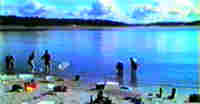|

They
are wonderful
|
|
Seaweed
Algae can be found on submerged rocks
as long as they are not chafed away or covered by sand. Where the sediment
is protected enough from the waves, soft
bottoms are seldom devoid of vegetation. There, they can attach themselves
to the bottom without being washed away.
More and more current and wave exposed areas, that were
once devoid of vegetation, are now
being covered by drifting thread-like green algae. A possible reason
for this is the increasing discharge of nutritious effluent from urbanisation,
agriculture, cellulose production and automoblie exhausts.
Gold brown patches of single-celled algae
Sand beach flora below the water line
consists of a great many small single-celled
alga. When waves wash up onto the beach and shift the sand, it
is usually these organisms that survive. Sometimes they can be so many,
that they appear as yellow-grey to dark brown patches on the sand. Many
of these small organisms belong to the diatom group, which is also an
important group amongst the plankton that floats about above the sand
bottoms.
Diatoms that creep about
on and amongst the grains of sand - they are so small that several hundred
can be placed on a single grain of sand. Their movements often follow
variations in the light, creeping down amongst the grains during the night,
and sitting on top of the sand during the day.
Other "plants”
Other groups that can be associated with
the sand beach flora (certain groups can use sunlight to produce food)
include flagellates, certain bacteria and fungi. It is very practical
to divide organisms into plants and animals, but in reality, nature is
much more complex.
|

|
Page 8
of 15
|

|
|